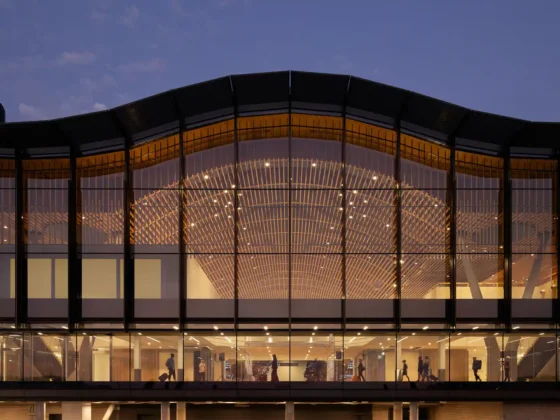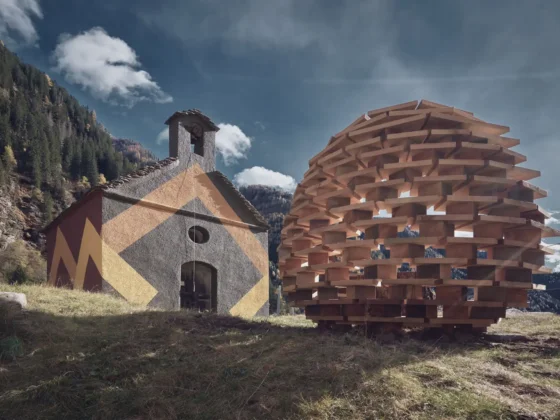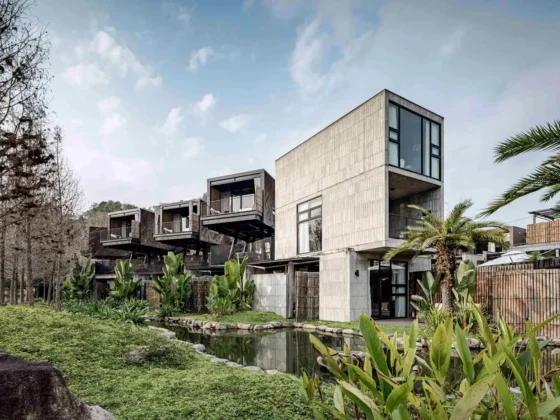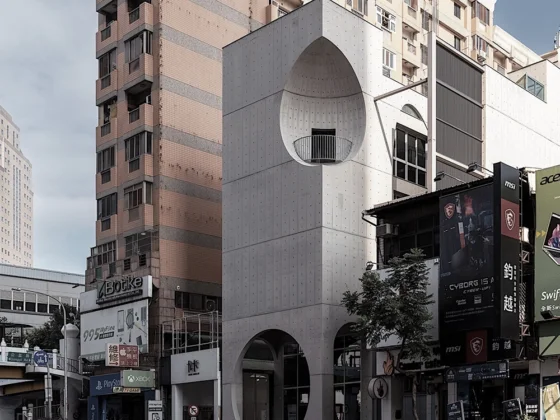Quingdao, China
An urban context and master plan located in the new CBD of Qingdao, Hai Tian Center by Archilier Architecture with China Construction Design International features three towers on the oceanfront with ocean views to its south and city views to the north.

Sitting on the beautiful oceanfront, with the tallest tower in both Qingdao and Shandong province, Hai-Tian Center represents the rich history of the city, speaks of its coastal identity, and looks to the future to become part of Qingdao citizens’ lives.
Hai-Tian Center has recently been awarded a 2022 International Architecture Awards Honorable Mention by The Chicago Athenaeum: Museum of Architecture and Design and The European Centre for Architecture Art Design and Urban Studies.
To maintain visual corridors from the city to the sea, the designers minimized the towers’ width and opened up the podium with a grand stair directly linking the urban core to the seafront promenade.
The project connects to the city at multiple levels with a basement link to subway lines and two-level urban plazas at both the seaside and the city side.
With an open sea view, its podium roof has become a popular concert and event venue in Qingdao.

Lined with cafes and shops, the open plazas are available for planned events, such as art shows and a variety of performances, while conveying a festive atmosphere even when specific programs are not offered.
With a 360-degree sea and city vista view, the observation deck and museum “Art-Above-the-Clouds” under an electrochromic glass dome at the crown are quickly becoming the city’s attractions.
The architects sought to establish this urban development not only as an icon but also as a public “living room” woven into the dynamic urban fabric of Qingdao.
The project is envisioned not as a static super-tall monument, but as a living organism, very much integrated into the city’s social and economic lives.
The master plan is quickly becoming the visible symbol of Qingdao.

The design of the three towers—one of which is the city’s tallest—reflects the city’s coastal character, sculpted with dynamic forms that represent the lapping waves and invoke the concept “Rhythm of the Sea.”
Drawing on the site’s rich history and proximity to the seashore, the designers formulated the “Rhythm of the Sea” as the project’s design narrative to reflect the movement and energy of ocean waves.
The site was previously home to the original Hai-Tian Hotel, the first 5-star hotel in both Qingdao city and Shandong Province.
Having once served as the city’s hospitality ‘hot spot,’ the site holds a special place in the city’s history and its citizens’ memories.
The designers thus used the original building’s hexagonal geometry as the tower plates’ starting point, paying homage to the site’s history.

They then introduced the “Rhythm of the Sea” by shifting the hexagon’s tips at the north and south ends progressively as the towers rise, creating a vertical wave along the building’s main elevations and thus metaphorically bringing the sea into the site.
With their design, the designers drew from the past while simultaneously creating a new narrative to represent Qingdao’s unique character.
Arching crests and surging waves are expressed at the podium as continuous undulating walls, while the sea’s gentler movements are articulated in the tower’s skin with triangular-shaped panel systems creating a rippling effect.
These panels shimmer as sunlight bounces off the building’s façade.
The overall project contains two five-star hotels, a conference center, a Class-A office space, a luxury apartment tower, and a five-story retail center.

Tower 2 contains the St. Regis hotel and high-end offices.
The hotel is on the upper levels with its sky lobby on the 52nd 52 with sweeping views.
The lobby transitions to a stunning central atrium with a signature cascading staircase that opens to the upper guestroom floors.
This atrium provides a visual connection between the major program spaces.
The hotel’s infinity pool is located on the floor below; reflecting the sky, the water in the pool visually merges with the sea below.

Tower 2’s special function space, the “Diamond Club” sits at the top of the building under an electrochromic glass dome.
It is the crown jewel of the tower providing the highest viewpoint in the whole city.
An observation deck and the museum “Art Above the Clouds” are right below the dome.
With a 360-degree view over the sea and city, this unique guest experience is enhanced by the three glass prisms projected outside the building which invite daring people to stand on a glass floor 336 meters above the ground.
Public guests have separate and direct access to all the function spaces above.

Located on a previously developed site in a dense urban area, the signature tower (Tower 2), at 369 meters high, received both USGBC’s LEED Gold and the top three-star rating from China’s Green Building Design Label.
The designers took a holistic approach towards building a sustainable development.
Among multiple strategies used, special attention was given to creating an efficient MEP system, providing air quality control with outdoor air delivery monitoring, while maximizing fresh air flow.
The towers were positioned on the site in such a way as to maximize natural light.
Local materials as well as low-emitting materials with recycled content were prioritized.

The project also provides ample bicycle parking, shower facilities, and a direct underground connection to the adjacent subway station.
The reflectivity rate of the glass used in the towers is also far lower than what’s required by the national standard.
LEED gold certified, the design of Tower 2 placed special emphasis on providing ample natural light and sweeping views.
Tower 2 is oriented so that more than 75% of the building occupants benefit from the view of the sea while 50% can enjoy both sea and city views.
The upper-floor occupants also enjoy Qingdao’s signature low clouds floating by.

The glass panel is Low-E ultra-white glass to further promote visibility to the outside.
Depth is also controlled so that the deepest workstation is less than 10 meters away from the perimeter with direct access to daylight.
Special attention was also given to indoor air quality.
Low-emitting building material was used to reduce off-gassing, and operable windows are integrated throughout the tower to increase air ventilation.
With easy access to nature, fresh air, daylight, and spectacular views, all promoting the wellbeing of the building occupants, employees in the complex are projected to have a 10% reduction in sick days and absenteeism.

Hai-Tian Center is also a key national pilot demonstration project of green building operation.
It used BIM as well as smart building technology with dynamic parametric models to reduce energy consumption, optimize efficient operation, monitor carbon output, extend 10% of equipment lifespan, and provide savings of 4.8 million RMB in energy use and 1 million in maintenance costs per year.
The project won the title of “New Landmark of China’s Towers” after completion, attracted Fortune 500 companies, stimulated tourism in the city, and resulted in as many as 20,000 new jobs.
The project is becoming an icon and the “living room” for the city, due to its height and seafront location but also its design and many attractions offered to the city’s residents and tourists.

These attractions include multiple tiers of food and beverage outlets, a vibrant shopping experiences in its retail center, outdoor concerts at the podium roof, and cultural venues like “Art Above the Clouds.”
The museum and observation deck have received 30,000+ visitors since June 20, 2021.
Overall, the designers sought to carry the city’s fond memory of the original Hai -Tian hotel previously on the same site into their design, while creating new forms with languages that represent the vigor and aspiration of an emerging new “first-line” coastal city in China.
With multiple vantage points of sea views, the development’s podium roof terraces, just like the ground floor plazas, extend the buildings’ interiors to the outside, offering dining, strolling, and socializing all in a signature garden atmosphere.


Project: Quingdao Hai Tian Center
Architects: Archilier Architecture
Associate Architects: China Construction Design International Co., Ltd. (CCDI)
Client: Private
Images: Courtesy of the Architects













